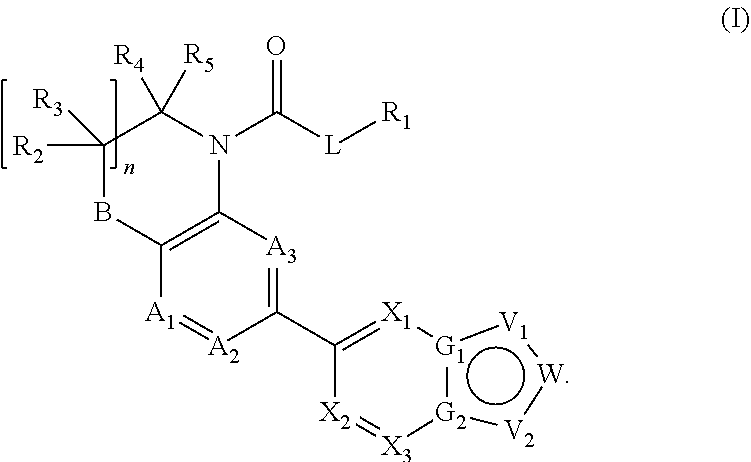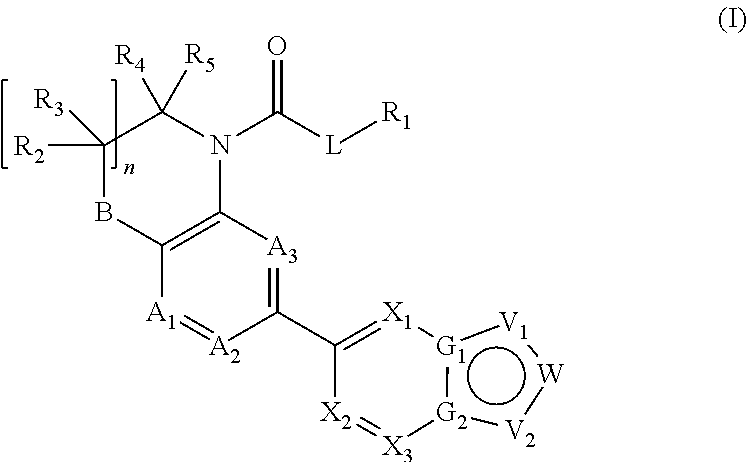Heteroaryl compounds as inhibitors of necrosis, composition and method using the same
a technology of heteroaryl compounds and necrosis inhibitors, applied in the field of heteroaryl compounds, can solve the problems of necrosis, cytoplasmic and organelle swelling and eventual lysis of cells, inflammatory response, local or total cerebral ischemia and hypoxia, and achieve the effect of inhibiting necrosis
- Summary
- Abstract
- Description
- Claims
- Application Information
AI Technical Summary
Benefits of technology
Problems solved by technology
Method used
Image
Examples
example 1
B2 Made by Method A
[0159]
Step 1: 1) Ethyl-2-((5-bromo-3-nitropyridin-2-yl)oxy)acetate (B1-1)
[0160]To a solution of 5-bromo-2-chloro-3-nitropyridine (6.0 g, 25.4 mmol) and ethyl 2-hydroxyacetate (2.9 g, 28.0 mmol) in THF (150 mL) was added slowly 60% NaH (1.3 g, 1.8 mmol) at 0° C. The mixture was stirred at room temperature for 8 h. After water (20 mL) was added to quench the reaction, the mixture was treated with brine (100 mL) and extracted with ethyl acetate (50 mL*2). The combined organic layers were dried over Na2SO4, filtered and concentrated. Then the solid was filtered to give the title compound as a yellow solid (5.5 g 71%). 1H NMR (400 MHz, CDCl3) δ 8.46 (d, J=2.0 Hz, 1H), 8.39 (d, J=1.6 Hz, 1H), 5.05 (s, 2H), 4.26-4.17 (m, 2H), 1.28 (t, J=7.2 Hz, 3H).
Step 2: 7-bromo-1H-pyrido[2,3-b][1,4]oxazin-2(3H)-one (B1-2)
[0161]To a solution of B1-1 (5.0 g, 16 mmol) in acetic acid (80 mL) was added slowly Fe (5.5 g, 98 mmol) at 70° C. The mixture was stirred at 70° C. for 3 h. After co...
example 2
B17 Made by Methods A and B
[0165]
Step 1: tetrahydro-2H-pyran-4-yl carbonochloridate (B17-1)
[0166]To a solution of bis(trichloromethyl)carbonate (23.7 g, 80 mmol) in 200 mL of dichloromethane was added dropwise pyridine (13.4 g, 220 mmol) at 0° C. After stirring for 10 min, a solution of tetrahydro-2H-pyran-4-ol (20.4 g, 200 mmol) in dichloromethane (50 mL) was added slowly. After the mixture was stirred for 1 h, the resulting solution was filtered. The filtrate was evaporated to give the crude title compound as a colorless oil (35 g).
Step 2: tetrahydro-2H-pyran-4-yl-7-bromo-2,3-dihydro-1H-pyrido[2,3-b][1,4]oxazine-1-carboxylate (B17-2)
[0167]A mixture of B1-3 (2.2 g, 10 mmol), DIPEA (12.9 g, 100 mmol) and B17-1 (4.9 g, 30 mmol) in toluene (70 mL) was stirred at 80° C. for 1 h. After cooling to room temperature, the mixture was treated with brine (50 mL) and extracted with ethyl acetate (50 mL*2). The combined organic layers were dried over Na2SO4, filtered and concentrated. The resid...
example 3
B14 Made by Method B
Step 1: tetrahydro-2H-pyran-4-yl7-(2-aminobenzo[d]thiazol-6-yl)-2,3-dihydro-1H-pyrido[2,3-b][1,4]oxazine-1-carboxylate hydrochloride (B14)
[0171]To a solution of B17 (50 mg, 0.1 mmol) in ethyl acetate (2 mL) was added 3N HCl / EA (5 mL) at room temperature. After stirred at room temperature for 12 h, the mixture was filtered to give the title compound as a white solid (36 mg, 92%). 1H NMR (400 MHz, DMSO-d6) δ 9.30 (s, 2H), 8.61 (s, 1H), 8.19 (s, 1H), 8.12 (s, 1H), 7.63 (d, J=7.8 Hz, 1H), 7.55 (d, J=8.3 Hz, 1H), 4.95 (s, 2H), 4.41 (s, 2H), 3.94 (s, 2H), 3.85-3.70 (m, 2H), 3.51 (t, J=8.5 Hz, 2H), 1.96 (d, J=12.2 Hz, 2H), 1.66 (d, J=8.6 Hz, 2H).
PUM
| Property | Measurement | Unit |
|---|---|---|
| detecting wavelength | aaaaa | aaaaa |
| detecting wavelength | aaaaa | aaaaa |
| temperature | aaaaa | aaaaa |
Abstract
Description
Claims
Application Information
 Login to View More
Login to View More - R&D
- Intellectual Property
- Life Sciences
- Materials
- Tech Scout
- Unparalleled Data Quality
- Higher Quality Content
- 60% Fewer Hallucinations
Browse by: Latest US Patents, China's latest patents, Technical Efficacy Thesaurus, Application Domain, Technology Topic, Popular Technical Reports.
© 2025 PatSnap. All rights reserved.Legal|Privacy policy|Modern Slavery Act Transparency Statement|Sitemap|About US| Contact US: help@patsnap.com



